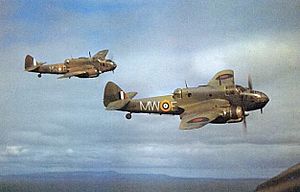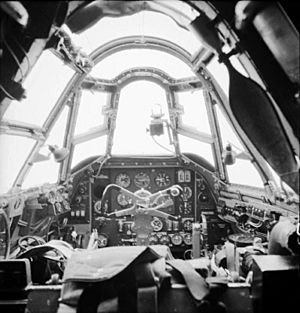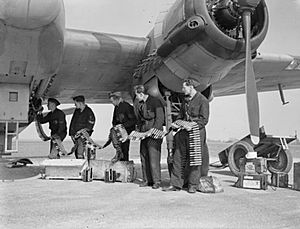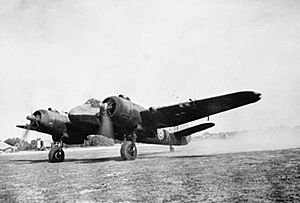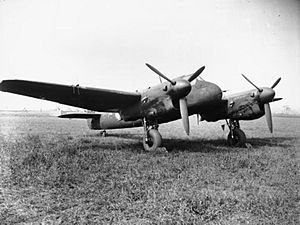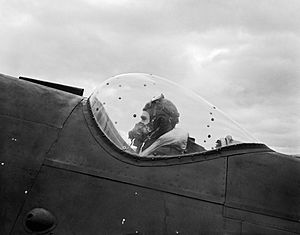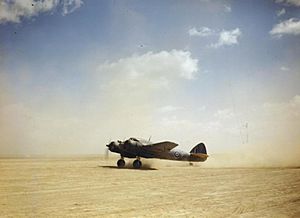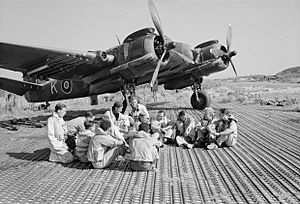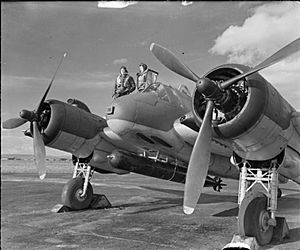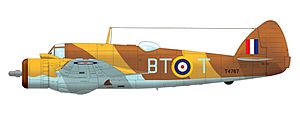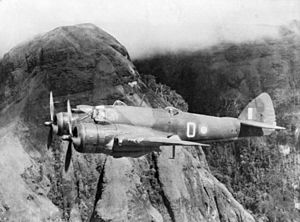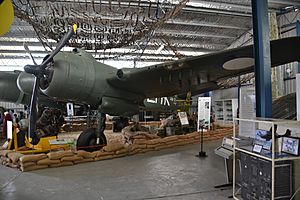Bristol Beaufighter facts for kids
Quick facts for kids Type 156 Beaufighter |
|
|---|---|
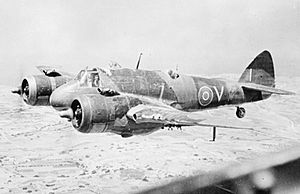 |
|
| Mark IC, T5043 'V', of No. 272 Squadron RAF in flight over Malta. | |
| Role | Heavy fighter / strike aircraft |
| Manufacturer | Bristol Aeroplane Company |
| First flight | 17 July 1939 |
| Introduction | 27 July 1940 |
| Retired | 1960 |
| Primary users | Royal Air Force Royal Canadian Air Force Royal Australian Air Force |
| Produced | May 1940–1946 |
| Number built | 5,928 |
| Developed from | Bristol Beaufort |
The Bristol Type 156 Beaufighter, often called the Beau, was a British multi-role aircraft. It was created during World War II by the Bristol Aeroplane Company. This powerful plane was first thought of as a heavy fighter. It was based on the Bristol Beaufort torpedo bomber.
The Beaufighter became a great night fighter. It started serving with the Royal Air Force (RAF) during the Battle of Britain. Its large size meant it could carry many weapons and early airborne radar without losing much speed.
The Beaufighter was used for many jobs. It was nicknamed Rockbeau when it carried rockets for ground attacks. It was called Torbeau when it was a torpedo bomber against Axis ships. It replaced the Beaufort in this role. Later, it mostly attacked ships and ground targets. The RAF Coastal Command used the most Beaufighters at one point. The Royal Australian Air Force (RAAF) also used it a lot to fight ships, like during the Battle of the Bismarck Sea.
Many air forces used the Beaufighter during the war. These included the RAF, Fleet Air Arm, RAAF, Royal Canadian Air Force, United States Army Air Forces, Royal New Zealand Air Force, South African Air Force, and the Free Polish Air Force. Some Beaufighters were also made in Australia by the Government Aircraft Factories (DAP). These are sometimes called DAP Beaufighters.
Contents
How the Beaufighter Was Developed
The Idea Behind the Beaufighter
The idea for the Beaufighter started in 1938. At that time, the Bristol Aeroplane Company saw that the Royal Air Force (RAF) urgently needed a long-range fighter. This fighter had to carry heavy weapons to cause a lot of damage. They looked at the Beaufort plane. They found it was very strong, especially its wings and tail. This meant it could be made faster and more agile like a fighter.
The Bristol design team, led by Leslie Frise, started working on a fighter version. This new plane would have cannons. It had to use the same parts as the Beaufort so they could easily switch production.
The Beaufort was a torpedo bomber and spy plane, so it wasn't very fast. To make the Beaufighter fast like a fighter, Bristol suggested using their new Hercules engines. These engines had about 1,500 horsepower. The Beaufort used 1,000 horsepower Bristol Taurus engines. The Hercules engines were bigger and more powerful. They needed bigger propellers. To make sure the propellers didn't hit the ground, the engines were placed in the middle of the wing. In October 1938, this project, called Type 156, was planned. In March 1939, it was named Beaufighter.
Bristol showed their idea for a Beaufort fighter to the Air Ministry. This happened when there were delays with another fighter, the Westland Whirlwind. Some people thought the Beaufighter was too big for a fighter. But the Air Staff liked the idea. They saw it as a temporary plane until the Whirlwind was ready.
On 16 November 1938, Bristol was officially allowed to start designing the plane in detail. They also got permission to build four test planes. One rule was that the plane should also be able to use the Rolls-Royce Griffon engine.
Bristol started building the first test plane from a Beaufort that was partly built. This helped speed things up. Bristol had promised to start making the planes by early 1940. They thought using many Beaufort parts would make it faster. But the main body of the plane needed more changes than expected. The Air Ministry had asked Bristol to look into a "slim fuselage" version. Because the "Beaufort cannon fighter" was a change of an existing design, it was expected to be built faster. The first test plane, R2052, was ready in six months. Two weeks before its first flight, the Air Ministry ordered 300 Beaufighters.
Testing and Improvements
On 17 July 1939, R2052, the first test plane, flew for the first time. It was not armed. This was just over eight months after work officially started. This fast progress was because many parts from the Beaufort were used. R2052 was first tested by Bristol at Filton Aerodrome. Early changes included making the elevator controls stronger and making the tail fin bigger. They also made the landing gear longer to handle more weight and hard landings.
During early tests, the first plane, R2052, reached 335 mph (539 km/h). This was at 16,800 feet (5,120 m). The second test plane, R2053, was slower at 309 mph (497 km/h). This was at 15,000 feet (4,572 m). Its performance was a bit disappointing. Also, there was a high demand for Hercules engines for other planes like the Short Stirling bomber. This made people think about using different engines for the Beaufighter.
Roy Fedden, the chief designer for Bristol engines, wanted to use the improved Hercules VI. But this engine needed a lot of development. So, the Rolls-Royce Merlin engine was chosen instead. This was until more Hercules engines could be made. The Merlin-powered plane was called the Beaufighter Mark IIF. Other planned versions with different engines were never built.
In February 1940, an order was placed for three Beaufighters to use the Merlin engine. The Merlin engine parts were designed by Rolls-Royce. This design was later used for the larger Avro Lancaster bomber. The first Merlin-powered plane flew in June 1940. Tests showed that the Merlin engines made the plane feel underpowered. It also tended to swing to the left during takeoff and landing. This caused many accidents. Out of 337 Merlin-powered planes, 102 were lost in accidents.
On 2 April 1940, the first Beaufighter was given to the RAF. Production planes started arriving on 27 July 1940. These planes had better aerodynamics. The weapons also changed. The first system for loading cannons was difficult. A new electrical system was then used. This was similar to Bristol's first idea. The first 50 production planes had only cannons. Later, six .303 Browning machine guns were added. This made the Beaufighter one of the most heavily armed fighters in the world. It could fire up to 780 pounds (354 kg) of bullets per minute. But in real life, it was less due to guns getting hot and limited ammo.
More weapon tests and changes happened during the Beaufighter's service. By mid-1941, 20 Beaufighters were used for testing. This included engine development and making the plane more stable. Some planes were changed to have a four-gun turret behind the pilot. But this made it hard for the pilot to get out in an emergency. Other tests involved putting larger 40 mm guns on the plane for ground attacks.
Making the Beaufighter
Large orders for the Beaufighter were placed when World War II started. One order was for 918 planes. In mid-1940, Lord Beaverbrook, the Minister of Aircraft Production, visited Bristol. He said the Beaufighter was very important for the war. He pushed for it to be ready quickly. Even though its size was once doubted, the Beaufighter became the best plane for carrying early radar. This radar was used for night fighting. It could do this without losing much flight time or weapon power. This made it very valuable as a night fighter.
To build the planes as fast as possible, many parts were made by other companies. Two large factories were set up for final assembly. One was run by the Fairey Aviation Company in Stockport. The other was run by Bristol in Weston-super-Mare. The number of Beaufighters made quickly increased.
From 1940 to 1941, more and more Beaufighters were built. On 7 December 1940, the 100th plane from the Filton factory was sent out. The 200th followed on 10 May 1941. The first Beaufighter from the Fairey factory flew on 7 March 1941. The first from Weston flew on 20 February 1941. Because so many planes were being made, there was a worry about not having enough Hercules engines. This could slow down production. So, the next version, the Beaufighter Mark II, used the Merlin engine instead. The first Mark II flew on 22 March 1941. Deliveries to squadrons started in late April 1941.
By mid-1941, Beaufighter production changed to meet the needs of RAF Fighter Command and RAF Coastal Command. Early planes could be used by either command. But later, their jobs and equipment became different. This led to special models being made. These were marked with F for Fighter Command and C for Coastal Command. For example, Coastal Command Beaufighters got special dive brakes. These were useful for dropping torpedoes.
Australia also started making Beaufighters in January 1943. This was because the British-made Beaufighters were very successful with the Royal Australian Air Force (RAAF). The Australian-made plane was called the "Mark 21". It was an attack and torpedo bomber. It had Hercules VII or XVIII engines and some small weapon changes. By September 1945, when British production ended, 5,564 Beaufighters had been built. When Australian production stopped in 1946, 364 Mark 21s had been made.
Beaufighter Design
The Bristol Beaufighter was a fighter plane based on the Beaufort torpedo-bomber. It was a two-engine, two-seat plane for long-range day and night fighting. The plane was made entirely of metal. It had three main parts. The wings were also made of metal and had two main supports. The wings had metal-framed ailerons with fabric covers. It also had hydraulic-powered flaps. The landing gear was also hydraulic. The brakes used air pressure.
The Beaufort's twin Bristol Taurus engines were not strong enough for a fighter. So, the Beaufighter used more powerful Bristol Hercules radial engines. These engines had two-speed superchargers. They powered three-bladed Rotol propellers. Both metal and wooden propellers were used. The extra power caused vibration problems during development. In the final design, the engines were placed on longer, more flexible supports. This moved the center of gravity forward. To fix this, the nose of the plane was made shorter. This was possible because the bomb aimer's space in the nose was no longer needed for a fighter. Most of the plane's body was behind the wing. With the engines and propellers further forward than the nose, the Beaufighter looked short and stubby.
The Beaufighter was very similar to the Beaufort, except for the engines. The wings, control surfaces, retractable landing gear, and back part of the fuselage were the same. The areas for the rear gunner and bomb-aimer were removed. Only the pilot sat in a fighter-style cockpit. The navigator, who also operated the radar, sat behind the pilot. He was under a small clear bubble where the Beaufort's gun turret used to be. Both crew members had their own escape hatch in the floor. The pilot's hatch was behind his seat. He had to lift himself over the seat to get out. The navigator's hatch was in front of him, making it easier to escape.
The Beaufighter's weapons were in different places on the lower body and wings. The bomb bay was removed. But small bombs could be carried outside. Four 20 mm Hispano Mark III cannons were in the lower fuselage. At first, these were fed by 60-round drums. The radar operator had to change them by hand. This was hard, especially at night. Soon, a belt-feed system replaced the drums. Six .303 inch (7.7 mm) Browning machine guns were also in the wings. Four were on the right wing and two on the left. This made the Beaufighter one of the most heavily armed fighters of its time. When Beaufighters became torpedo bombers, they used their guns to stop enemy anti-aircraft fire. The force of the cannons and machine guns firing could slow the plane down by about 25 knots.
The Beaufighter was often used as a night fighter, especially during the Battle of Britain. It was built at the same time as the first British airborne interception radars became available. These two technologies worked well together for night fighting. The plane's four 20 mm cannons were in the lower fuselage. This left the nose empty for the radar antennas. Early radar equipment was too big for single-engine fighters. But it fit well in the Beaufighter's large body. At night, the radar helped the plane find enemy aircraft. The heavy fighter was still fast enough to catch German bombers. With its strong weapons, it could do a lot of damage. Early radars had limited range. But improved radars came out in January 1941. This quickly made the Beaufighter one of the best night fighters of that time.
Beaufighter in Action
First Flights and Battles
Compared to other fighters, the Beaufighter Mark I was quite heavy and slow. It weighed 16,000 pounds (7,000 kg). Its top speed was 335 mph (540 km/h) at 16,800 feet (5,000 m). It was the only heavy fighter available at the time. The Westland Whirlwind fighter project had been cancelled. On 12 August 1940, the first production Beaufighter was sent to RAF Tangmere for tests. On 2 September 1940, four squadrons became the first to get the plane. They started changing from their Blenheim IF planes. This change took several months. On the night of 17/18 September 1940, Beaufighters flew their first night patrol. On 25 October 1940, a Beaufighter got its first confirmed kill, a Dornier Do 17 bomber.
The first Beaufighters did not have radar for night fighting. These were installed later in 1940. On the night of 19/20 November 1940, a radar-equipped Beaufighter got its first kill, a Junkers Ju 88. Better radar units were added in early 1941. This made the Beaufighter very good at fighting the Luftwaffe (German air force) at night. By March 1941, Beaufighters shot down half of the German planes claimed by British fighters.
In late April 1941, the first two Beaufighter Mark II planes were sent to squadrons. The Mark II was also given to the Fleet Air Arm (Navy air force). A night-fighter Beaufighter Mark VIF came out in March 1942. It had AI Mark VIII radar. The Beaufighter was great as a night fighter. But it also did other jobs. As the faster de Havilland Mosquito took over night fighting in 1942, the Beaufighter helped in other ways. It attacked ships, ground targets, and flew long-range missions in all major war areas.
On 12 June 1942, a Beaufighter did a very daring raid. A Beaufighter Mark 1C flew from Thorney Island to occupied Paris. It flew very low in daylight. It dropped a French flag on the Arc de Triomphe. It also shot at the Gestapo headquarters.
The Beaufighter soon served overseas. Its toughness and reliability made it popular with crews. But it was heavy to control and not easy to fly. Landing was especially hard for new pilots. Because of wartime shortages, some Beaufighters did not have equipment to stop their propellers from spinning if an engine failed. This caused some planes to crash and aircrew to die.
In the Mediterranean, the United States Army Air Forces (USAAF) received 100 Beaufighters in summer 1943. They got their first victory in July 1943. These squadrons flew convoy escort and ground-attack missions during the day. But they mainly flew as night fighters. Even when the Northrop P-61 Black Widow fighter arrived, USAAF Beaufighters kept flying night missions until late in the war. By autumn 1943, enough Mosquitos were available to replace the Beaufighter as the RAF's main night fighter. By the end of the war, about 70 pilots became aces flying Beaufighters. At least one captured Beaufighter was used by the Luftwaffe.
Coastal Command Missions
The RAF Coastal Command needed a long-range heavy fighter like the Beaufighter. In early 1941, Bristol started developing the Beaufighter Mark IC for this role. The first 97 Coastal Command Beaufighters were made quickly. They couldn't add the planned extra fuel tanks in the wings. So, 50-gallon tanks from the Vickers Wellington were put on the floor. In April/May 1941, this new Beaufighter version started serving in Malta. This first use was very successful. The plane stayed in that area for the rest of the war. In June 1941, 272 Squadron in Malta claimed to have destroyed 49 enemy planes. The Beaufighter was very good in the Mediterranean against Axis ships, planes, and ground targets. Coastal Command became the main user of the Beaufighter. It replaced their older Beaufort and Blenheim planes.
In 1941, Coastal Command Beaufighters started attacking German targets over France and Belgium. This was to stop Germany from sending forces to the Eastern Front. In December 1941, Beaufighters helped in Operation Archery. They provided covering fire while British Commandos landed on a Norwegian island. In 1942, Beaufighters regularly patrolled the Bay of Biscay. They stopped German planes that were attacking Allied anti-submarine patrols. Beaufighters also worked with the British Eighth Army in the Western Desert Campaign. They often shot at ground targets.
In mid-1942, Coastal Command started getting the improved Beaufighter Mark VIC. By late 1942, Mark VICs were fitted with torpedo-carrying gear. They could carry British 18-inch (450 mm) or US 22.5-inch (572 mm) torpedoes. Observers didn't like carrying the torpedo. They couldn't use the escape hatch until the torpedo was dropped. In April 1943, 254 Squadron made the first successful torpedo attacks with Beaufighters. They sank two merchant ships off Norway.
The Hercules Mark XVII engine was put into the Mark VIC plane. This created the TF Mark X (torpedo fighter), known as the "Torbeau". The Mark X became the most produced version of the Beaufighter. The attack version of the Torbeau was called the Mark XIC. Beaufighter TF Xs could attack ships very precisely at wave-top height. They used torpedoes or RP-3 (60 lb) rockets. Early Mark X models had ASV (air-to-surface vessel) radar. This was replaced in late 1943 by AI Mark VIII radar. This new radar was in a "thimble-nose" dome. It allowed attacks in all weather and at night.
The North Coates Strike Wing of Coastal Command developed special tactics. They used large groups of Beaufighters. Some used cannons and rockets to stop anti-aircraft fire. Others, the Torbeaus, attacked at low level with torpedoes. These tactics started in mid-1943. In ten months, they sank 29,762 tons (84,226 m3) of shipping. The North Coates Strike Wing was the largest anti-shipping force of World War II. They sank over 150,000 tons (424,500 m3) of shipping and 117 vessels. They lost 120 Beaufighters and 241 aircrew.
Beaufighter in the Pacific War
The Beaufighter arrived in Asia and the Pacific in mid-1942. A British journalist said that Japanese soldiers called it the "whispering death". This was because its engines were quiet. The Beaufighter's Hercules engines used special valves that made less noise.
In the South-East Asian Theatre, the Beaufighter Mark VIF flew from India. It was a night fighter. It also attacked Japanese supply lines in Burma and Thailand. Mark X Beaufighters flew long-range missions over Burma during the day. These fast, low-level attacks were very effective. This was true even with bad weather and makeshift repair places.
Southwest Pacific Battles
The Royal Australian Air Force (RAAF) used the Beaufighter a lot during World War II. On 20 April 1942, the RAAF got its first Beaufighter IC from Britain. The last one arrived on 20 August 1945. The first RAAF Beaufighters went to No. 30 Squadron in New Guinea and No. 31 Squadron in North-West Australia.
Before Australian-made Beaufighters arrived, the Beaufighter Mark IC was used for anti-shipping missions. The most famous was the Battle of the Bismarck Sea. Beaufighters were used to suppress enemy fire. They flew with USAAF Douglas A-20 Boston and North American B-25 Mitchell bombers. In the battle, 13 Beaufighters from No. 30 Squadron flew very low. They provided heavy covering fire for the attacking bombers. The Japanese convoy thought they were being attacked by torpedoes from Beauforts. They made the mistake of turning their ships towards the Beaufighters. This allowed the Beaufighters to cause severe damage to the ships' anti-aircraft guns and crews. They used their four 20 mm nose cannons and six wing machine guns. The Japanese ships were then open to low-level bombing attacks. Eight transport ships and four destroyers were sunk. Five Allied aircraft were lost, including one Beaufighter.
A war reporter and filmmaker, Damien Parer, recorded the Beaufighters' role in the Battle of the Bismarck Sea. He flew in one of the No. 30 Squadron planes. This battle made the Beaufighter one of the most famous planes in Australian service. On 2 November 1943, a Beaufighter, A19-54, won a race against an A-20 Boston bomber.
After the War
From late 1944, RAF Beaufighter units were involved in the Greek Civil War. They finally left in 1946.
The Beaufighter was replaced in some jobs by the Bristol Type 164 Brigand. This plane used parts from the Beaufighter's failed partner, the Bristol Buckingham.
The air forces of Portugal, Turkey, and the Dominican Republic also used the Beaufighter. The Israeli Air Force briefly used some ex-RAF planes bought secretly in 1948.
Many Mark 10 planes were changed into target tugs after the war. They were called TT.10s. They served with several RAF support units until 1960. The last flight of a Beaufighter in RAF service was by TT.10 RD761 on 12 May 1960.
Beaufighter Versions
- Beaufighter Mark IF: A two-seat night fighter with AI Mark IV radar and Hercules XI engines.
- Beaufighter Mark IC: This was the "C" for Coastal Command version. Many were changed to carry bombs.
- Beaufighter Mark IIF: The Short Stirling bomber needed Hercules engines more. So, the Mark IIF night fighter used Rolls-Royce Merlin XX engines instead.
- Beaufighter Mark III/IV: These were planned versions with Hercules and Merlin engines. They would have a new, slimmer body. They would carry six cannons and six machine guns for better performance. But the cost of changing the production line stopped these versions.
- Beaufighter Mark V: These planes had a Boulton Paul turret with four 0.303 inch (7.7 mm) machine guns behind the cockpit. Only two (Merlin-engined) Mark Vs were built.
- Beaufighter Mark VI: The Hercules engine came back with this major version in 1942. Over 1,000 were built. It had a new tailplane.
- Beaufighter Mark VIC: This was the Coastal Command version, similar to the Mark IC.
- Beaufighter Mark VIF: A night fighter equipped with AI Mark VIII radar.
- Beaufighter Mark VI (ITF): An temporary torpedo fighter version.
- Beaufighter Mark VII/VIII/IX: Proposed Australian-built versions with different Hercules engines, but not built.
- Beaufighter TF Mark X: A two-seat torpedo fighter, nicknamed the "Torbeau". Hercules XVII engines with special superchargers improved low-altitude performance. This was the last major version (2,231 built). Later models had a dorsal fin.
- Beaufighter Mark XIC: A Coastal Command version of the Mark X, without torpedo gear.
- Beaufighter Mark XII: A proposed long-range version of the Mark 11 with extra fuel tanks, not built.
- Beaufighter Mark 21: The Australian-made DAP Beaufighter. It had Hercules XVII engines. It carried four 20 mm cannons in the nose and four Browning .50 inch (12.7 mm) guns in the wings. It could also carry eight 5 inch (130 mm) High Velocity Aircraft Rockets, two 250 lb (110 kg) bombs, two 500 lb (230 kg) bombs, and one Mark 13 torpedo.
- Beaufighter TT Mark 10: After the war, many RAF Beaufighters were changed into target tug planes.
- Australian experimental prototypes: These included versions with twin Merlin engines and a 40mm Bofors gun.
Who Used the Beaufighter?
Beaufighters Still Around
Museum Displays
- Australia
- Beaufighter Mark XXI A8–186 – Built in Australia in 1945. It served at the end of World War 2. After being on a farm, it was bought in 1965 by the Camden Museum of Aviation in Sydney. It was restored using parts from many places. It has "Beau-gunsville" nose art.
- Beaufighter Mark XXI A8–328 – This Australian-built plane is at the Australian National Aviation Museum near Melbourne. It was finished on the day the Pacific War ended. It was used as a target-tug after the war.
- Beaufighter Mark XXI A8-386 – Only the nose section is displayed at the Camden Museum of Aviation. It has "Harry's Baby" nose art.
- United Kingdom
- Beaufighter TF.X, RD253 – Displayed at the Royal Air Force Museum in London. This plane flew with the Portuguese Air Force in the late 1940s. It was used for training before returning to the UK in 1965. It was restored in 1968 using parts from many sources.
- Beaufighter TF.X RD220 – This plane is being restored at the National Museum of Flight in Scotland. After the war, it served with the Portuguese naval air arm. It was acquired by National Museums Scotland in 2000.
- United States
- Beaufighter Mark Ic A19-43 – On display at the National Museum of the United States Air Force in Ohio since 2006. It flew in combat with the 31 Squadron Royal Australian Air Force. It is painted as T5049, Night Mare, a USAAF Beaufighter. This plane shot down a German bomber in 1944. It was found in Australia in 1971 and acquired by the USAF Museum in 1988.
Being Restored or Stored
- Beaufighter TF.X RD867 – Stored at the Canada Aviation Museum. It is waiting for restoration. It is mostly complete but needs engines and other parts. It was received from the RAF Museum in 1969.

- Beaufighter Mark Ic A19-144 – Owned by The Fighter Collection at Duxford. This plane has been undergoing a long restoration to flying condition. It is made from parts of two different planes.
Several sunken Beaufighters are known. In 2005, the wreck of a Beaufighter was found off the coast of Malta. It likely crashed in March 1943 after an engine failure. It lies upside down in 38 meters (125 ft) of water.
Another wreck is in 34 meters (112 ft) of water near the Greek island of Paros. This might be Beaufighter TF.X LX998. It was shot down in November 1943 after destroying a German plane. The Australian crew survived.
A Mark VIC Beaufighter, serial A19-130, lies in 204 feet (62 m) of water off Fergusson Island in the Pacific. It crashed in August 1943 after an engine failure. Both crew and their passenger escaped. The wreck was found in 2000.
In May 2020, the wreck of a Beaufighter TF.X, believed to be JM333, was found on Cleethorpes beach in England. The plane crashed on 21 April 1944 after both engines failed. The crew survived.
Beaufighter TF Mark X Details
Data from Jane's Fighting Aircraft of World War II, The Bristol Beaufighter I & II.
General characteristics
- Crew: 2
- Length: 41 ft 4 in (12.60 m)
- Wingspan: 57 ft 10 in (17.63 m)
- Height: 15 ft 10 in (4.83 m)
- Wing area: 503 sq ft (46.7 m2)
- Airfoil: root: RAF-28 (18%); RAF-28 (10%)
- Empty weight: 15,592 lb (7,072 kg)
- Max takeoff weight: 25,400 lb (11,521 kg) with one torpedo
- Fuel capacity: 550 imp gal (660 US gal; 2,500 L) normal internal fuel
- Maximum fuel capacity: 682 imp gal (819 US gal; 3,100 L) (with optional 2x 29 imp gal (35 US gal; 130 L) external tanks / 1x 24 imp gal (29 US gal; 110 L) tank in lieu of port wing guns / 1x 50 imp gal (60 US gal; 230 L) tank in lieu of stbd. wing guns)
- Powerplant: 2 × Bristol Hercules XVII or Bristol Hercules XVIII 14-cylinder air-cooled sleeve-valve radial piston engines, 1,600 hp (1,200 kW) each
- Propellers: 3-bladed constant-speed propellers
Performance
- Maximum speed: 320 mph (515 km/h; 278 kn) at 10,000 ft (3,000 m)
- Range: 1,750 mi (1,521 nmi; 2,816 km)
- Service ceiling: 19,000 ft (5,800 m)
- Rate of climb: 1,600 ft/min (8.1 m/s)
Armament
- Guns: * 4 × 20 mm (0.787 in) Hispano Mark II cannon (240 rounds per gun) in nose
- 6 x .303 (7.7 mm) Browning machine guns in wings (four on the right, two on the left, optional, replacing internal long range fuel tanks)
- 1 × manually operated 0.303 in (7.7 mm) Browning for observer
- Rockets: 8 × RP-3 60 lb (27 kg) rockets
- Bombs: 2× 250 lb (110 kg) bombs or 1× British 18 inch (45 cm) torpedo or 1x Mark 13 torpedo
See also
 In Spanish: Bristol Beaufighter para niños
In Spanish: Bristol Beaufighter para niños


